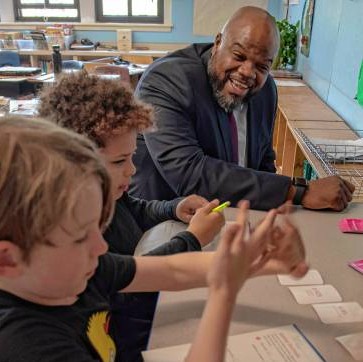Nearly four years after COVID-19 first shuttered schools, students are still missing class at rates unprecedented in the past two decades.
In an effort to reverse that trend, Patrick Tutwiler, the state’s education secretary, will make his television debut this week to deliver the message that “school is where kids belong.”
Tutwiler’s public service announcement is one part of a multilingual campaign by the state’s K-12 education department, including billboards and ads on radio and public transit.
In a 30-second TV spot, Tutwiler appeals directly to the community, saying that “school can be a place to heal and grow, to be with friends, to have the support of a whole team of adults.”
“Let’s work together to make attendance a priority,” he concludes.
The television and radio ads will air in English and Spanish throughout the state, including on Spanish-language networks like Univision, UniMás and Telemundo.
The multi-pronged campaign is the latest sign that state education officials are trying to curb elevated rates of absenteeism — a stubborn legacy of the pandemic.
They’ve dedicated $4 million in funding to help school districts combat absenteeism across the commonwealth. Meanwhile, Jeff Riley, the state’s K-12 education commissioner, has proposed holding districts accountable if they fail to increase their rates of consistent attendance.
As for the campaign launching Wednesday, “we’re not casting blame or pointing the finger at anyone. This is about bringing attention to the issue,” Tutwiler said in an interview.
Chronic absenteeism — defined under state law as missing at least 10% of school days in a school year — is linked to lower social engagement as well as slower achievement in reading and math. Officials worry that persistently high rates in Massachusetts and nationwide will hold back the ongoing academic and emotional recovery.
Before taking the helm as the state’s education secretary, Tutwiler led the Lynn Public Schools. During his first two years as superintendent, Tutwiler and his staff reduced chronic absenteeism from 19% in 2017 to under 17% in 2019-20, according to state data.
ADVERTISEMENT
But during the following year, the absenteeism rate surged to new heights in Lynn and elsewhere, as schooling went remote and COVID-19 wreaked havoc on public health, employment and housing.
The latest available data shows that 22% of students statewide were chronically absent in the 2022-23 school year. That’s nearly twice as high as pre-pandemic levels, which hovered persistently around 12% to 13%, but down from its peak of 29% in the spring of 2022.
Tutwiler has long argued that absenteeism is often driven by the “unmet needs” of students and their families, including stable housing. And indeed, among the 59 Massachusetts schools and districts where 30% or more of students were chronically absent last year, all but seven enroll majority low-income students.

